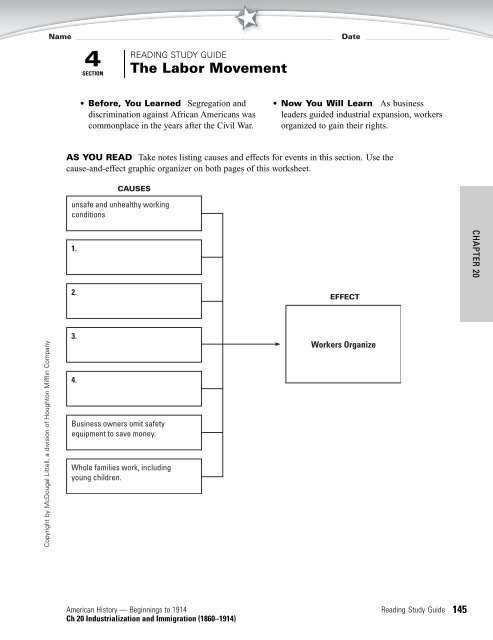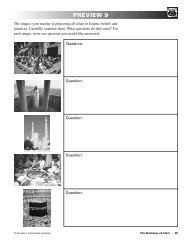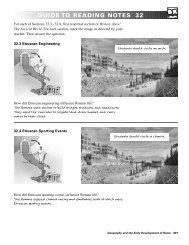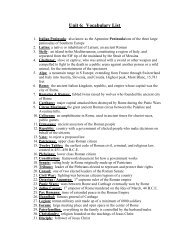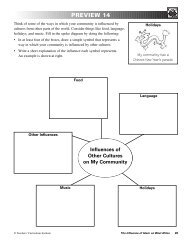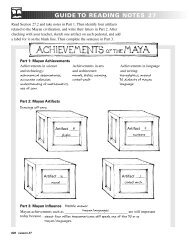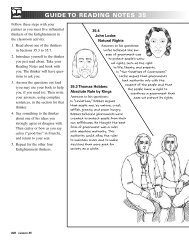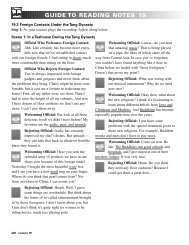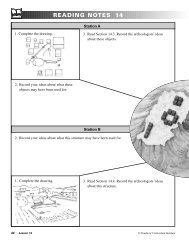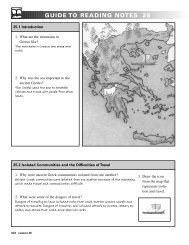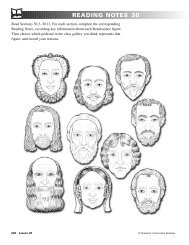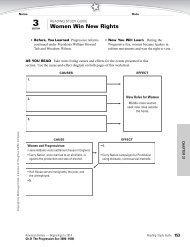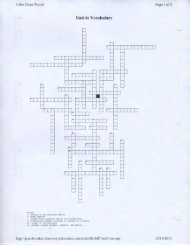Reading Study Guide Section 4 - Mr. Selby's Social Studies Page
Reading Study Guide Section 4 - Mr. Selby's Social Studies Page
Reading Study Guide Section 4 - Mr. Selby's Social Studies Page
Create successful ePaper yourself
Turn your PDF publications into a flip-book with our unique Google optimized e-Paper software.
Name<br />
4<br />
SECTION<br />
★<br />
READING STUDY GUIDE<br />
★<br />
The Labor Movement<br />
Date<br />
• Before, You Learned Segregation and<br />
discrimination against African Americans was<br />
commonplace in the years after the Civil War.<br />
• Now You Will Learn As business<br />
leaders guided industrial expansion, workers<br />
organized to gain their rights.<br />
AS YOU READ Take notes listing causes and effects for events in this section. Use the<br />
cause-and-effect graphic organizer on both pages of this worksheet.<br />
CAUSES<br />
unsafe and unhealthy working<br />
conditions<br />
1.<br />
CHAPTER 20<br />
2.<br />
EFFECT<br />
Copyright by McDougal Littell, a division of Houghton Mifflin Company<br />
3.<br />
4.<br />
Business owners omit safety<br />
equipment to save money.<br />
Whole families work, including<br />
young children.<br />
Workers Organize<br />
American History — Beginnings to 1914 <strong>Reading</strong> <strong>Study</strong> <strong>Guide</strong> 145<br />
Ch 20 Industrialization and Immigration (1860–1914)
Name<br />
★<br />
★<br />
Chapter 20, SECTION 4: THE LABOR MOVEMENT, CONTINUED<br />
Date<br />
EFFECT<br />
Business leaders hire strike breakers to break<br />
the unions.<br />
CAUSE<br />
5.<br />
Workers Organize<br />
Police arrest socialists, anarchists, and union<br />
leaders.<br />
6.<br />
CHAPTER 20<br />
MARK IT UP! Circle<br />
each term where it appears<br />
in your notes and be sure<br />
you understand its meaning.<br />
If a term does not appear,<br />
write the term outside the box<br />
where it best belongs.<br />
SKILLBUILDER<br />
7.<br />
Knights of Labor<br />
socialism<br />
“I ran and I left everything— pocketbook.<br />
I was running and the people were all<br />
at the door. I saw the people throwing<br />
themselves out the window. I wouldn’t<br />
dare. I didn’t have the courage. ‘I’m<br />
not going out, I’d rather die here,’ that’s<br />
what I said. The door was locked. We<br />
were about a hundred people. We were<br />
hollering and crying. We waited a long<br />
time. We didn’t feel any of the flames,<br />
but it was getting warm. The fires went<br />
to the windows.”<br />
Haymarket Affair<br />
Samuel Gompers<br />
—Pauline Cuoio Pepe, from You Must Remember This by Jeff<br />
Kisselhoff<br />
American Federation of Labor<br />
(AFL)<br />
Homestead Strike<br />
Pullman Strike<br />
Eugene V. Debs<br />
8. MARK IT UP! Circle the two words that tell<br />
why people are trying to leave the building.<br />
9. MARK IT UP! Underline the sentence that<br />
tells why people are throwing themselves out<br />
the window.<br />
Copyright by McDougal Littell, a division of Houghton Mifflin Company<br />
146 <strong>Reading</strong> <strong>Study</strong> <strong>Guide</strong> American History — Beginnings to 1914<br />
Ch 20 Industrialization and Immigration (1860–1914)


